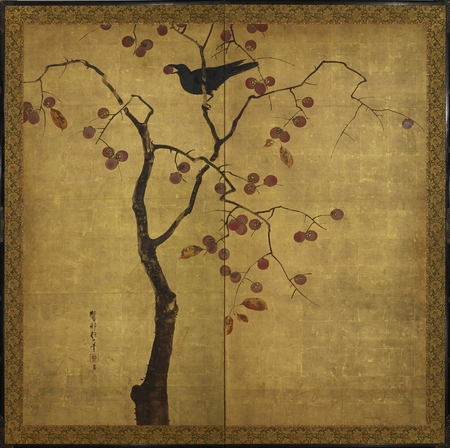Product Description
7290 A two-fold paper screen painted in ink and colour on a gold ground with a karasu (crow) perched in a kaki (persimmon) tree holding a ripened fruit in its mouth.
Signed: Ōson Hōitsu hitsu (painted by Ōson Hōitsu)
Seals:
Upper: Uge
Lower: Monsen
Japan 19th century Edo period
Dimensions: H. 71″ x W. 71″ (180cm x 180cm)
Sakai Hōitsu (1761-1828)
Born into a high ranking and cultivated family Sakai Hōitsu had a privileged upbringing giving him the opportunity to study Noh, calligraphy, tea ceremony, music and painting.
Hōitsu first studied painting in the Kanō style but his unending curiosity led him to study almost every major contemporary painting style such as Ukiyo-e, the Maruyama school and Nanga (literati painting) before devoting his considerable skills to Rimpa.
In 1797 Hōitsu became a monk an act which relieved him from his formal family obligations allowing him to study old masters such as Ogata Korin (1658-1716) and his brother Ogata Kenzan (1663-1743) in great depth. This study eventually led to Hoitsu publishing three books of woodblock prints, two dedicated to the works of the Ogata brothers and the third to his own oeuvre; Kōrin Hyakuzu (1815), Kenzan Iboku Gafu (1823), and Oson Gafu respectively.
In October 1817 Hōitsu hung a placard in his studio located in Otsuka which read uge an (lit. rain flower). It is generally believed that he began to use Uge as a gō (art name) from this time and marks the most innovative period of his career.
A similar two-fold screen by Sakai Hōitsu depicting a kaki (persimmon) tree is in the collection of the Metropolitan Museum of Art, New York and illustrated in Silver Wind, The Ars of Sakai Hōitsu (1761-1828), p.136-7, an exhibition held at the Japan Society Gallery, New York, 2012.
Works by the artist can be found in the collections of: Gitter-Yelen, New Orleans Museum of Art; Smithsonian Museum of Art, Washington D.C.; Victoria and Albert Museum of Art, London; Asia Society, New York; Cleveland Museum of Art, Ohio; Joe Price Collection, USA; Hosomi Museum, Kyoto; Idemitsu Museum of Arts, Tokyo; Kyoto National Museum, Kyoto; LA County Museum of Art, California; Metropolitan Museum of Art, New York; MOA Museum of Art, Shizuoka; Museum of Fine Arts, Boston; Museum of Imperial Collections, Sannomaru Shozokan; National Gallery of Victoria, Australia; New Orleans Museum of Art, Louisiana; Smithsonian Museum of Art, Washington D.C.; Tokyo National Museum, Tokyo; Worcester Art Museum, Massachusetts.









